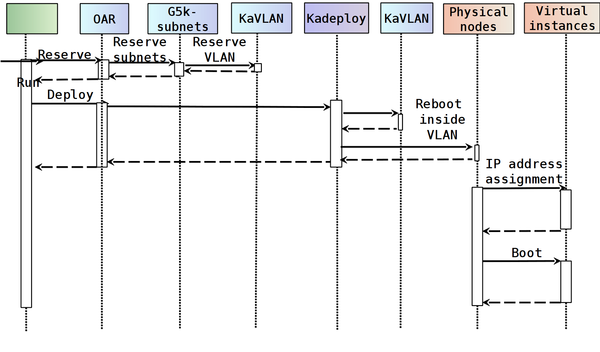Booting and Using Virtual Machines on Grid'5000
Overview
The goal of this tutorial is to introduce the use of large amount of virtual machines overs the Grid'5000 platform.
After a short part about Grid'5000 specifications and the requirements of this session, users will be presented a set of scripts and tools designed over the Grid'5000 software stack to deploy and interact with a significant number of virtual machines.
These instances can then be used at the user convenience in order to investigate particular concerns.
Grid'5000 specifications
When booting KVM instances over the platform, we need physical hosts that supports hardware virtualisation. During the deployment, we are in charge of configuring the IP network used by virtual machines throught network isolation capabilities of Grid'5000 and the subnet reservation system. It enables the use of an IP network ranging from ranging from /22 to /16 subnets, and ensures the communications with the various instances.
Deployment
Booking the resources
The first step is to retrieve the last version of the scripts
Move to the folder containing the code
Book the g5k resources according to the desired time and duration of your experiment
We will now consider as master site the site from which you book the ressources and executes the scripts.
This script will return you an OAR that includes the reservation of the nodes, a virtual network and a subnet
Execute the oar request returned by getmaxgridnodes.sh (don't forget to redirect it as shown in the example)
The master site is sophia in the following example.
Deploying and configuring the physical machines
Move to the Flauncher directory
Get the list of nodes and connect to the OAR grid job
You are now connected to the grid OAR job
Display the list of nodes
Move to the Flauncher directory
Deploy the nodes
Deploy the vlan and set the hypervisor (Warning : Use lowercase letter and repeat the master site as the first site)
We use a service node during the process.
Retrieve the service node
service_node=$(sed -n '/sophia/p' ./log/machines-list.txt | head -n1)
Connect to the service node
Usage
Retrieving the infrastructure informations
The service node contains all the informations about the deployed infrastructure.
Those informations can be accessed through various getters functions according to the desired informations.
Example : Retrieving the mapping between the reserved IP and the nodes
Please consult the README file for complete description of the available getters.
Creation of the Virtual Machines
Create a single virtual machine on a host
It is possible to create a single virtual machine by using the following script
The creation needs an IP adress(IP) , an amount of RAM memory(MEMORY), the current site and node and a arbitrary ID.
Create all the virtual machines from a service node
When the booting involve a large amount of virtual machines, it is necessary to describe the desired infrasctructure to enable an automatic and remote deployment.
#list of nodes node0 4 20 8 node1 4 20 8 node2 4 20 8 #list of VMs vm00 1 1 1 2147483647 vm01 1 1 1 2147483647 vm02 1 1 1 2147483647 vm03 1 1 1 2147483647 vm04 1 1 1 2147483647 vm05 1 1 1 2147483647 #initial configuration node0 vm00 vm03 node1 vm01 vm04 node2 vm02 vm05 #end of configuration
In this particular configuration, we declare 3 physical nodes and 6 virtual machines.
The last part of the configuration describes a simple mapping of 2 vitrual machines on each node.
(nodeX must designate the physical hostname of your infrastructure)
We can now create virtual machines on each host according to the specified configuration file, from the service node.
All the virtual instances are started at the same time, using a hierarchical structure mong the physical nodes.The correlation between name and IP
is stored in a dedicated file propagated on each physical node. This allows
us to identify and communicate with all the virtual machines.
At the end of the operation, the instances previously described are booted and available for experiments.
Interaction with the Machines
We need to be control,monitor and communicate with both the host OSes and the guest instances spread across the infrastructure at any time.
For that purpose, the following scripts are based on hierarchical communication structures to ensure a large-scale communication with the physical and/or virtual instances.
Execute remote commands
Execute a command on a list of nodes using a tree distribution
Copy files
Copy a file on a list of node using a tree distribution
In Practice : 10240 Virtual Machines on 512 Physical Hosts
Considering that physical machines must support hardware virtualization to start KVM instances, the largest experiment that has been conducted up to now involved 10240 KVM instances upon 512 nodes through 4 sites and 10 clusters. The whole setup is performed in less than 30 minutes with about 10 minutes spent on the deployment of the nodes, 5 minutes for the installation and configuration of the required packages on the physical hosts, while the rest is dedicated to the booting of the virtual machines. The result of that work opens doors to the manipulation of virtual machines thoughout a distributed infrastructure like traditionnal operating systems handle process on a local node.
Useful Tips
Booking grid resources
- Provide the request that retrieves the maximum number of nodes that is available during the time slot defined on specific clusters
Deployments
- Ensure a minimum amount of deployed nodes
To ensure that 95% (rounded down) of the reserved nodes are correctly deployed (3 attempts max), instead of running:
Run:
NB_NODES=$(sort -u $OAR_NODE_FILE | wc -l) MIN_NODES=$(($NB_NODES * 95/100)) /grid5000/code/bin/katapult3 --deploy-env squeeze-x64-prod --copy-ssh-key --min-deployed-nodes $MIN_NODES --max-deploy-runs 3
Communication
- About the Saturation of ARP tables
Tools
- Network isolation over Grid'5000 : KaVLAN
- Booking a range of IP adresses : Subnet Reservation System
- Deployment of nodes : Kadeploy3
- Execution Remote commands : TakTuk
